Health Protection Systems and Emergencies: A Case Study on Swine Flu
VerifiedAdded on 2023/06/17
|16
|2740
|337
AI Summary
This article discusses the background, principles of protection and practice, the emergency situation caused by the Swine Flu. It also discusses the procedure of health protection, response, and the role of authorities in it. The article also aims to look at the evaluation of health protection work and recovery phases applied in it.
Contribute Materials
Your contribution can guide someone’s learning journey. Share your
documents today.
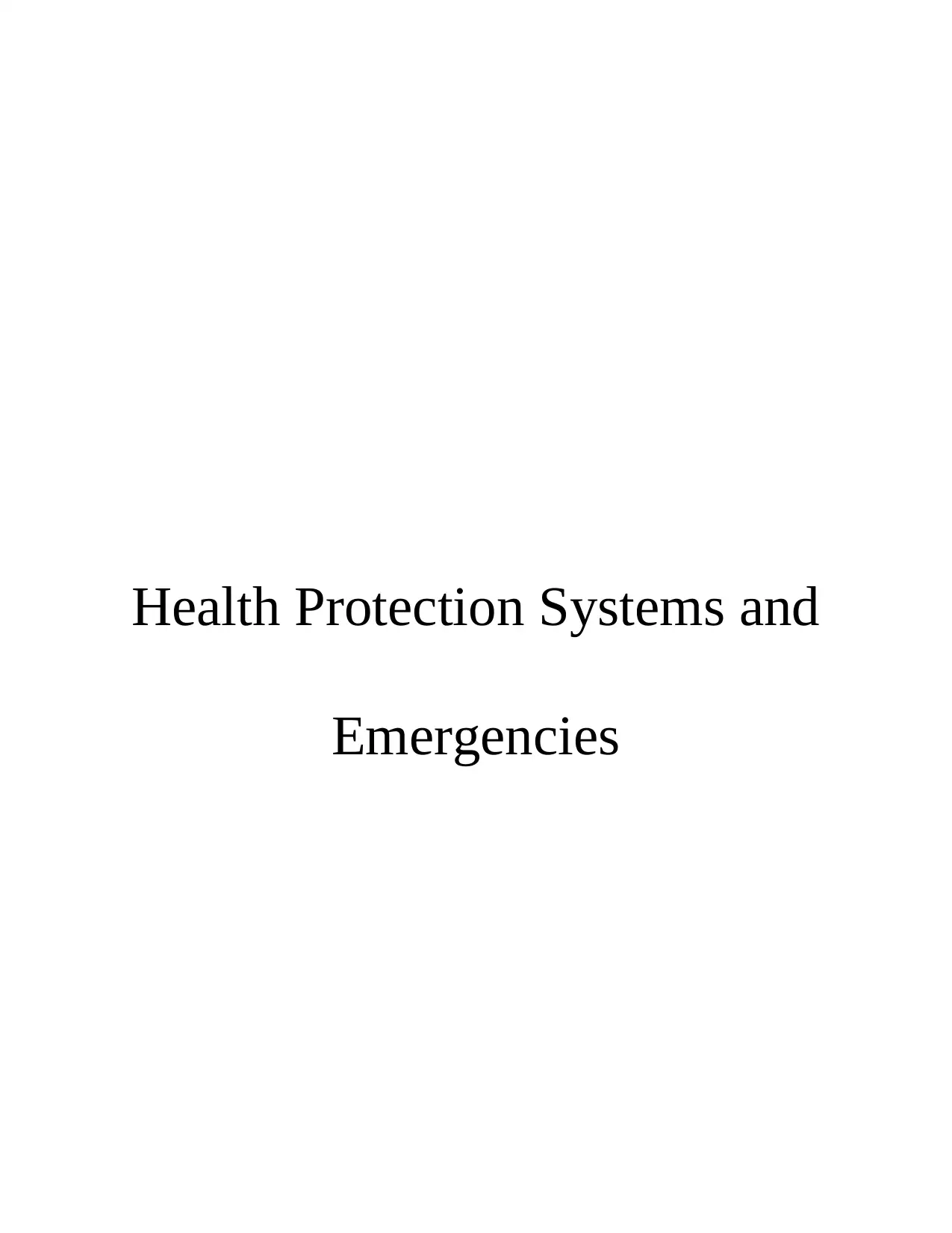
Health Protection Systems and
Emergencies
Emergencies
Secure Best Marks with AI Grader
Need help grading? Try our AI Grader for instant feedback on your assignments.
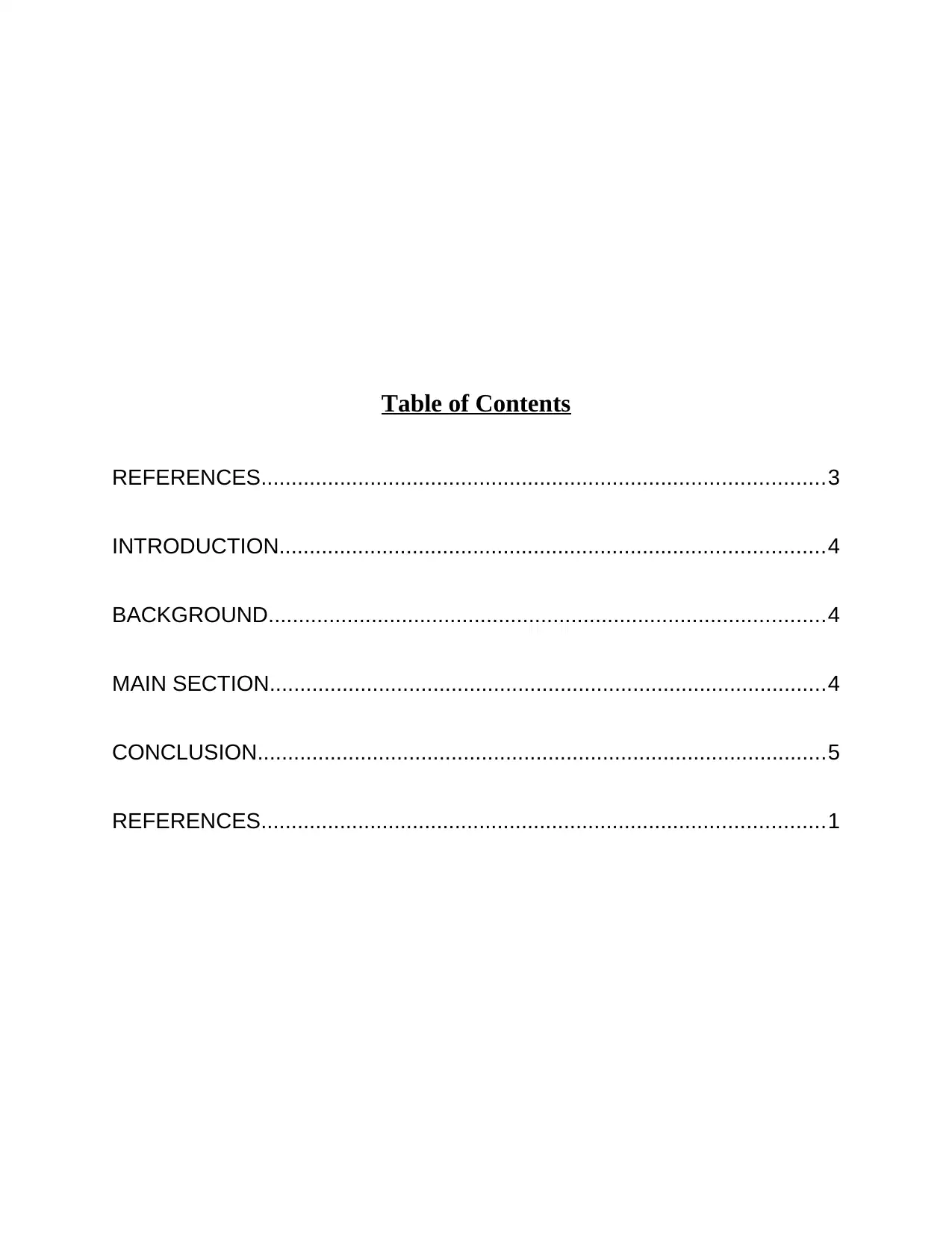
Table of Contents
REFERENCES.............................................................................................3
INTRODUCTION..........................................................................................4
BACKGROUND............................................................................................4
MAIN SECTION............................................................................................4
CONCLUSION..............................................................................................5
REFERENCES.............................................................................................1
REFERENCES.............................................................................................3
INTRODUCTION..........................................................................................4
BACKGROUND............................................................................................4
MAIN SECTION............................................................................................4
CONCLUSION..............................................................................................5
REFERENCES.............................................................................................1
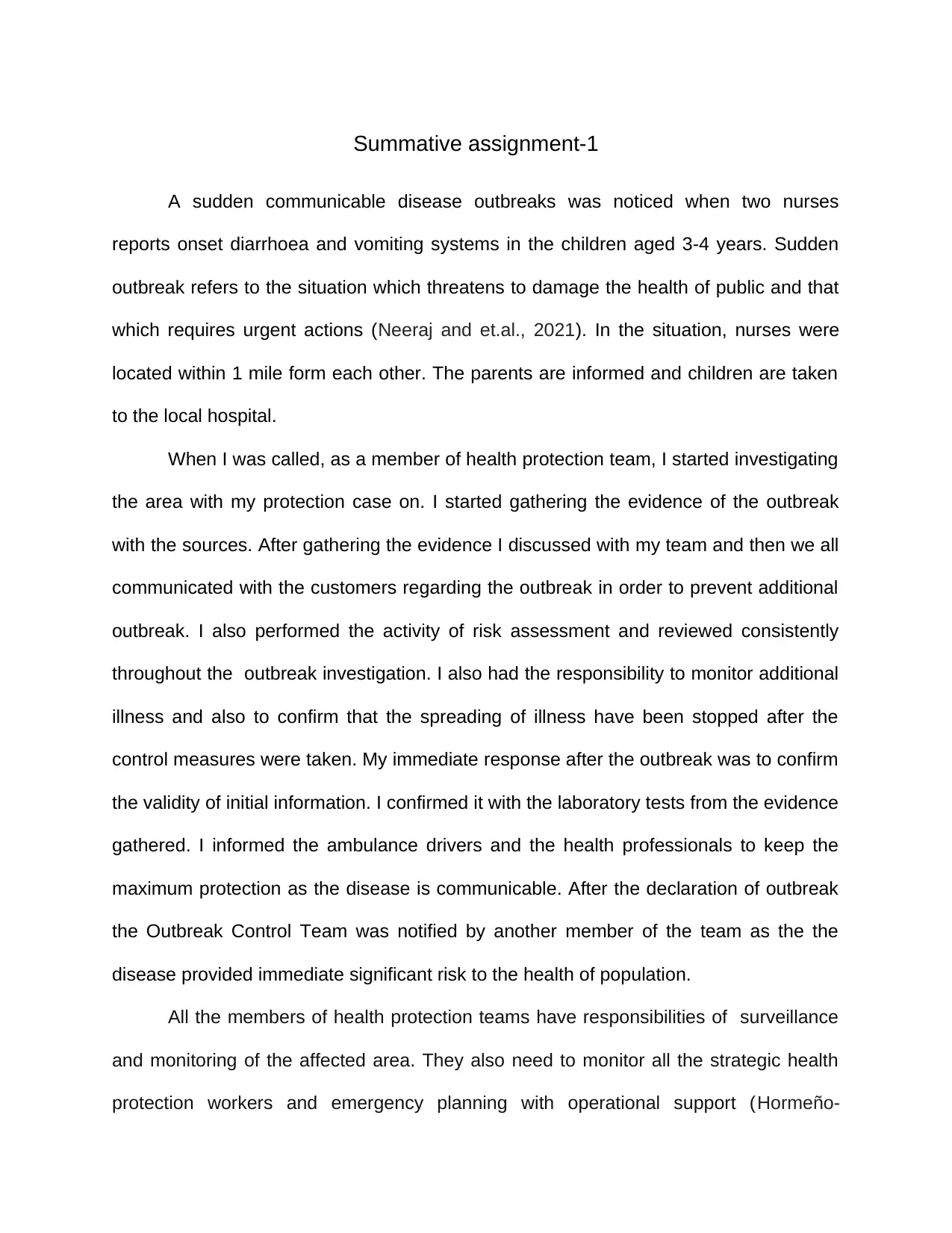
Summative assignment-1
A sudden communicable disease outbreaks was noticed when two nurses
reports onset diarrhoea and vomiting systems in the children aged 3-4 years. Sudden
outbreak refers to the situation which threatens to damage the health of public and that
which requires urgent actions (Neeraj and et.al., 2021). In the situation, nurses were
located within 1 mile form each other. The parents are informed and children are taken
to the local hospital.
When I was called, as a member of health protection team, I started investigating
the area with my protection case on. I started gathering the evidence of the outbreak
with the sources. After gathering the evidence I discussed with my team and then we all
communicated with the customers regarding the outbreak in order to prevent additional
outbreak. I also performed the activity of risk assessment and reviewed consistently
throughout the outbreak investigation. I also had the responsibility to monitor additional
illness and also to confirm that the spreading of illness have been stopped after the
control measures were taken. My immediate response after the outbreak was to confirm
the validity of initial information. I confirmed it with the laboratory tests from the evidence
gathered. I informed the ambulance drivers and the health professionals to keep the
maximum protection as the disease is communicable. After the declaration of outbreak
the Outbreak Control Team was notified by another member of the team as the the
disease provided immediate significant risk to the health of population.
All the members of health protection teams have responsibilities of surveillance
and monitoring of the affected area. They also need to monitor all the strategic health
protection workers and emergency planning with operational support (Hormeño-
A sudden communicable disease outbreaks was noticed when two nurses
reports onset diarrhoea and vomiting systems in the children aged 3-4 years. Sudden
outbreak refers to the situation which threatens to damage the health of public and that
which requires urgent actions (Neeraj and et.al., 2021). In the situation, nurses were
located within 1 mile form each other. The parents are informed and children are taken
to the local hospital.
When I was called, as a member of health protection team, I started investigating
the area with my protection case on. I started gathering the evidence of the outbreak
with the sources. After gathering the evidence I discussed with my team and then we all
communicated with the customers regarding the outbreak in order to prevent additional
outbreak. I also performed the activity of risk assessment and reviewed consistently
throughout the outbreak investigation. I also had the responsibility to monitor additional
illness and also to confirm that the spreading of illness have been stopped after the
control measures were taken. My immediate response after the outbreak was to confirm
the validity of initial information. I confirmed it with the laboratory tests from the evidence
gathered. I informed the ambulance drivers and the health professionals to keep the
maximum protection as the disease is communicable. After the declaration of outbreak
the Outbreak Control Team was notified by another member of the team as the the
disease provided immediate significant risk to the health of population.
All the members of health protection teams have responsibilities of surveillance
and monitoring of the affected area. They also need to monitor all the strategic health
protection workers and emergency planning with operational support (Hormeño-
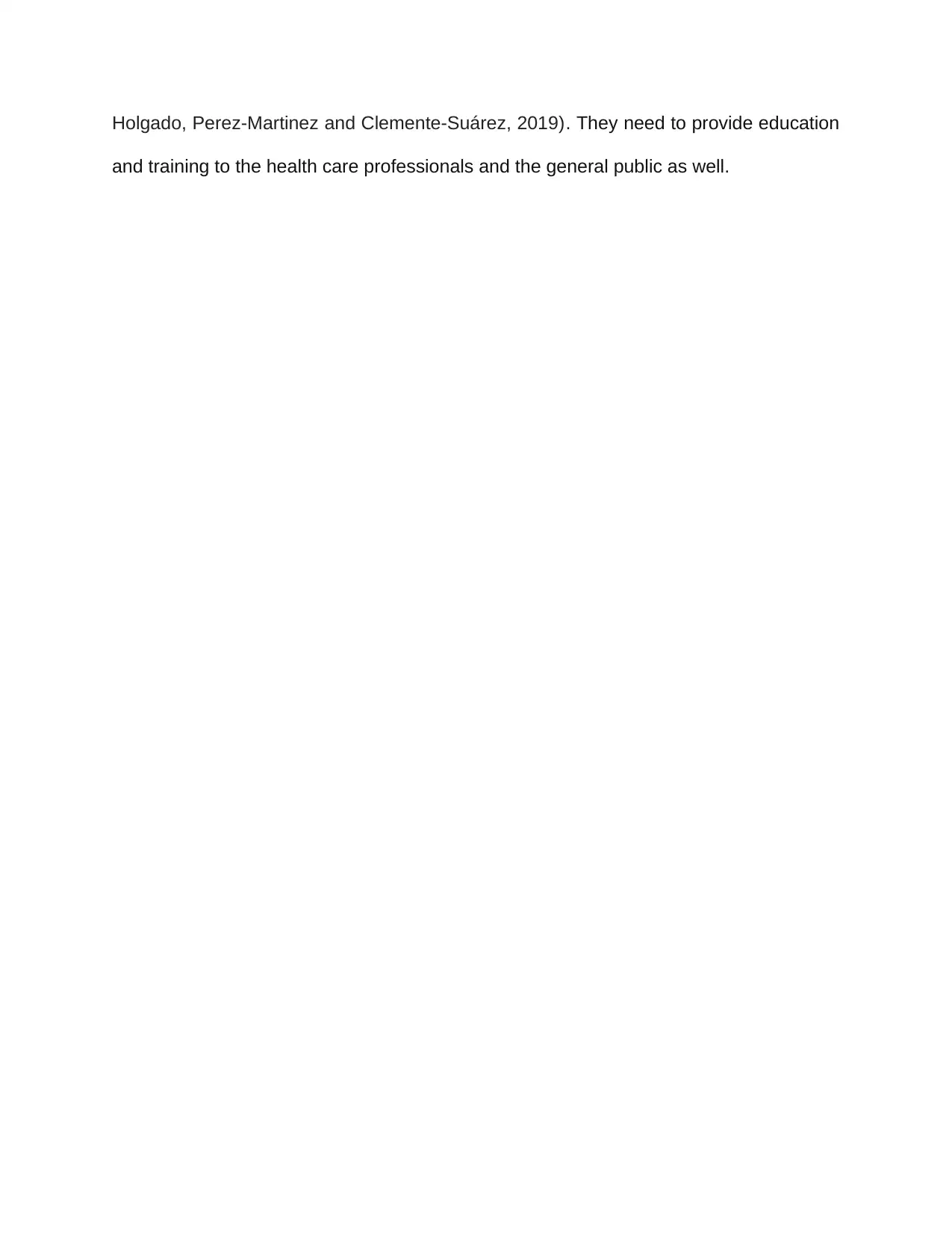
Holgado, Perez-Martinez and Clemente-Suárez, 2019). They need to provide education
and training to the health care professionals and the general public as well.
and training to the health care professionals and the general public as well.
Secure Best Marks with AI Grader
Need help grading? Try our AI Grader for instant feedback on your assignments.
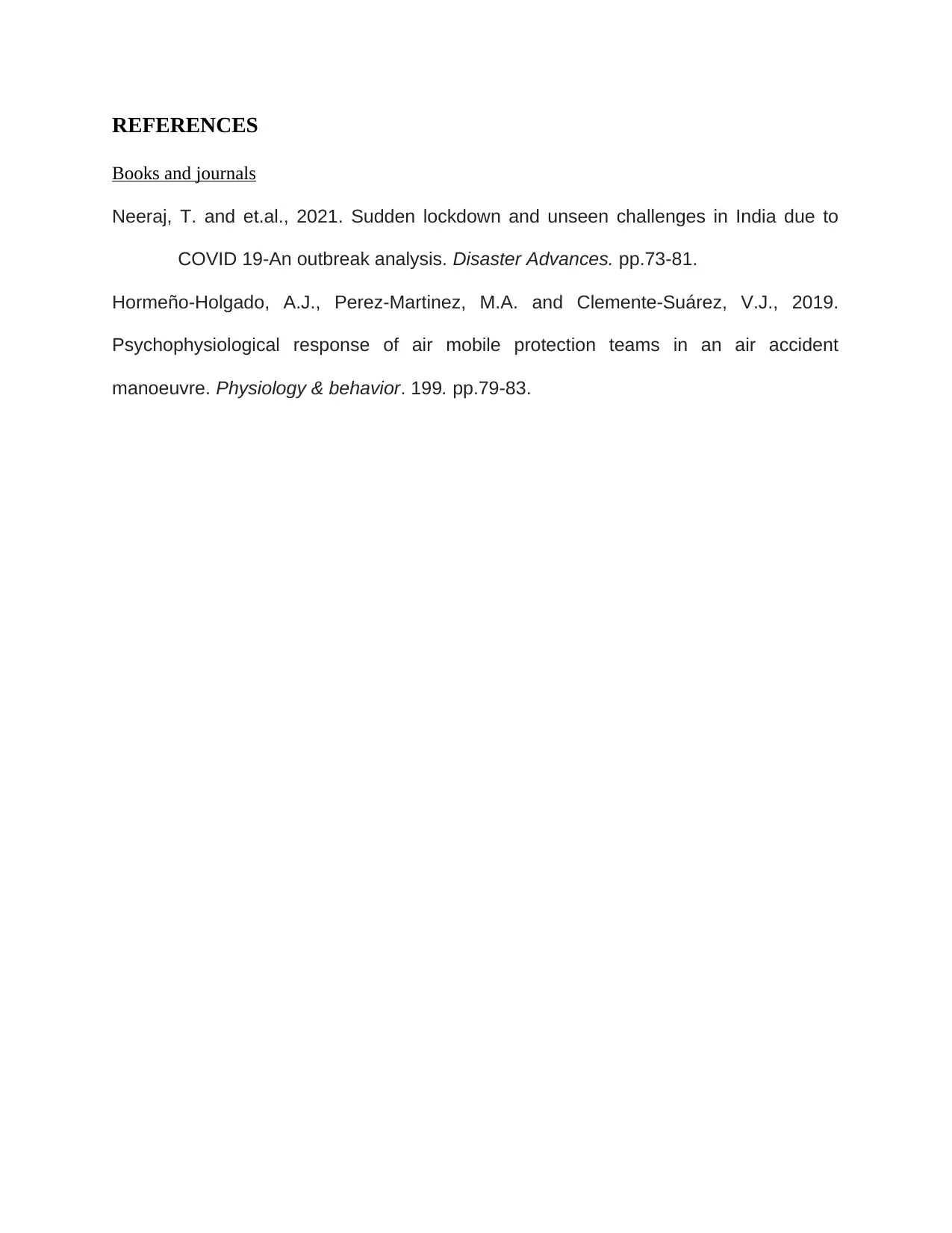
REFERENCES
Books and journals
Neeraj, T. and et.al., 2021. Sudden lockdown and unseen challenges in India due to
COVID 19-An outbreak analysis. Disaster Advances. pp.73-81.
Hormeño-Holgado, A.J., Perez-Martinez, M.A. and Clemente-Suárez, V.J., 2019.
Psychophysiological response of air mobile protection teams in an air accident
manoeuvre. Physiology & behavior. 199. pp.79-83.
Books and journals
Neeraj, T. and et.al., 2021. Sudden lockdown and unseen challenges in India due to
COVID 19-An outbreak analysis. Disaster Advances. pp.73-81.
Hormeño-Holgado, A.J., Perez-Martinez, M.A. and Clemente-Suárez, V.J., 2019.
Psychophysiological response of air mobile protection teams in an air accident
manoeuvre. Physiology & behavior. 199. pp.79-83.
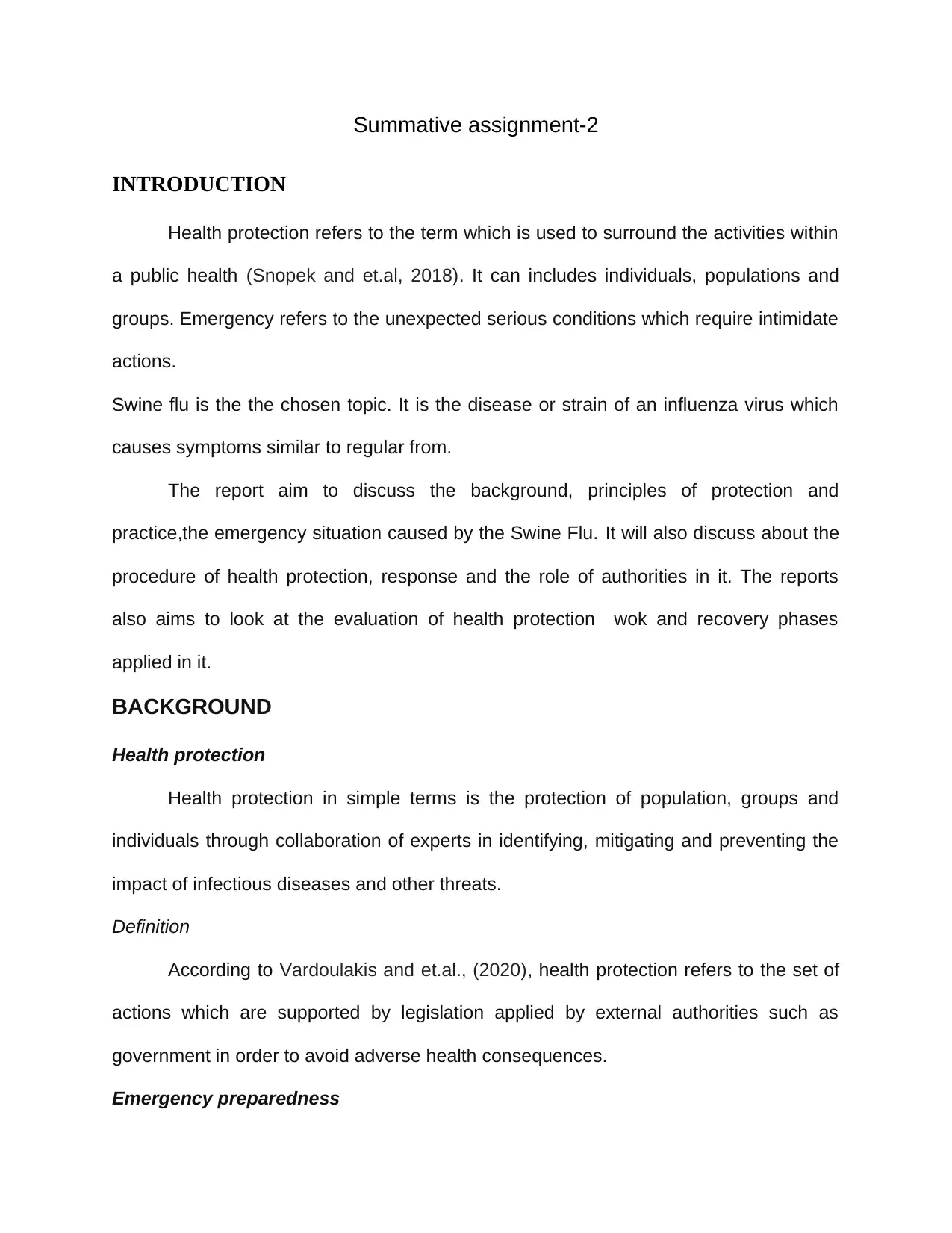
Summative assignment-2
INTRODUCTION
Health protection refers to the term which is used to surround the activities within
a public health (Snopek and et.al, 2018). It can includes individuals, populations and
groups. Emergency refers to the unexpected serious conditions which require intimidate
actions.
Swine flu is the the chosen topic. It is the disease or strain of an influenza virus which
causes symptoms similar to regular from.
The report aim to discuss the background, principles of protection and
practice,the emergency situation caused by the Swine Flu. It will also discuss about the
procedure of health protection, response and the role of authorities in it. The reports
also aims to look at the evaluation of health protection wok and recovery phases
applied in it.
BACKGROUND
Health protection
Health protection in simple terms is the protection of population, groups and
individuals through collaboration of experts in identifying, mitigating and preventing the
impact of infectious diseases and other threats.
Definition
According to Vardoulakis and et.al., (2020), health protection refers to the set of
actions which are supported by legislation applied by external authorities such as
government in order to avoid adverse health consequences.
Emergency preparedness
INTRODUCTION
Health protection refers to the term which is used to surround the activities within
a public health (Snopek and et.al, 2018). It can includes individuals, populations and
groups. Emergency refers to the unexpected serious conditions which require intimidate
actions.
Swine flu is the the chosen topic. It is the disease or strain of an influenza virus which
causes symptoms similar to regular from.
The report aim to discuss the background, principles of protection and
practice,the emergency situation caused by the Swine Flu. It will also discuss about the
procedure of health protection, response and the role of authorities in it. The reports
also aims to look at the evaluation of health protection wok and recovery phases
applied in it.
BACKGROUND
Health protection
Health protection in simple terms is the protection of population, groups and
individuals through collaboration of experts in identifying, mitigating and preventing the
impact of infectious diseases and other threats.
Definition
According to Vardoulakis and et.al., (2020), health protection refers to the set of
actions which are supported by legislation applied by external authorities such as
government in order to avoid adverse health consequences.
Emergency preparedness
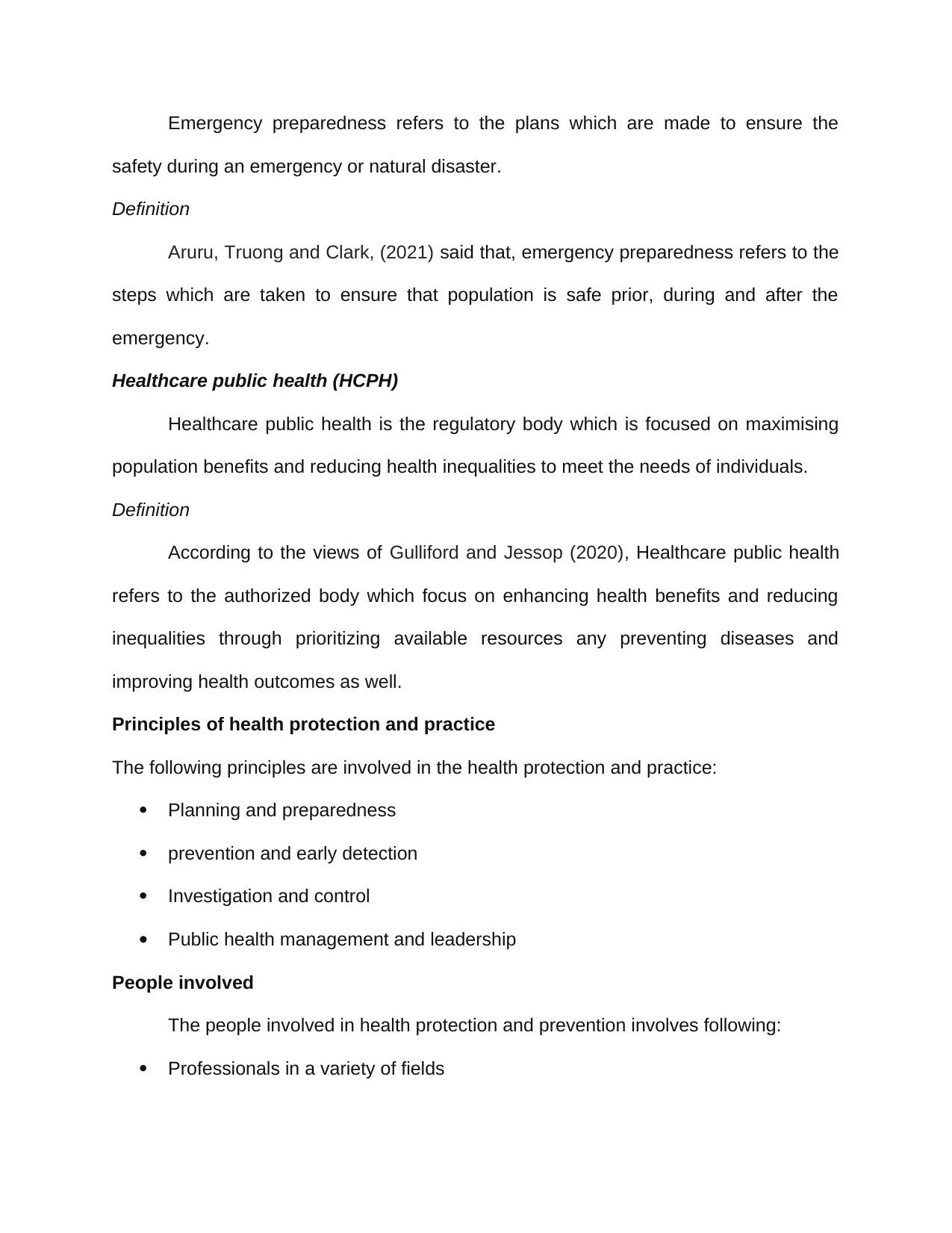
Emergency preparedness refers to the plans which are made to ensure the
safety during an emergency or natural disaster.
Definition
Aruru, Truong and Clark, (2021) said that, emergency preparedness refers to the
steps which are taken to ensure that population is safe prior, during and after the
emergency.
Healthcare public health (HCPH)
Healthcare public health is the regulatory body which is focused on maximising
population benefits and reducing health inequalities to meet the needs of individuals.
Definition
According to the views of Gulliford and Jessop (2020), Healthcare public health
refers to the authorized body which focus on enhancing health benefits and reducing
inequalities through prioritizing available resources any preventing diseases and
improving health outcomes as well.
Principles of health protection and practice
The following principles are involved in the health protection and practice:
Planning and preparedness
prevention and early detection
Investigation and control
Public health management and leadership
People involved
The people involved in health protection and prevention involves following:
Professionals in a variety of fields
safety during an emergency or natural disaster.
Definition
Aruru, Truong and Clark, (2021) said that, emergency preparedness refers to the
steps which are taken to ensure that population is safe prior, during and after the
emergency.
Healthcare public health (HCPH)
Healthcare public health is the regulatory body which is focused on maximising
population benefits and reducing health inequalities to meet the needs of individuals.
Definition
According to the views of Gulliford and Jessop (2020), Healthcare public health
refers to the authorized body which focus on enhancing health benefits and reducing
inequalities through prioritizing available resources any preventing diseases and
improving health outcomes as well.
Principles of health protection and practice
The following principles are involved in the health protection and practice:
Planning and preparedness
prevention and early detection
Investigation and control
Public health management and leadership
People involved
The people involved in health protection and prevention involves following:
Professionals in a variety of fields
Paraphrase This Document
Need a fresh take? Get an instant paraphrase of this document with our AI Paraphraser
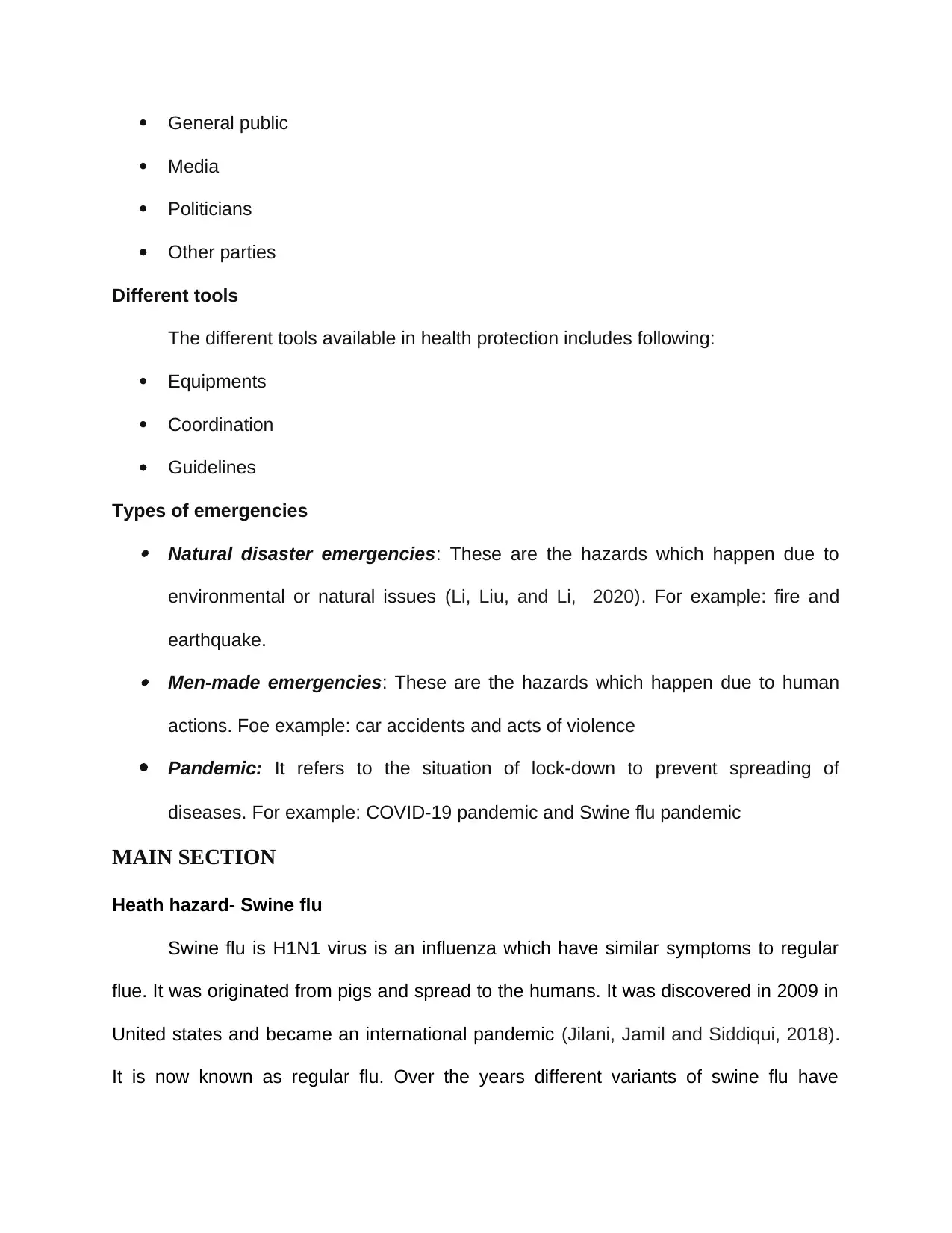
General public
Media
Politicians
Other parties
Different tools
The different tools available in health protection includes following:
Equipments
Coordination
Guidelines
Types of emergencies Natural disaster emergencies: These are the hazards which happen due to
environmental or natural issues (Li, Liu, and Li, 2020). For example: fire and
earthquake. Men-made emergencies: These are the hazards which happen due to human
actions. Foe example: car accidents and acts of violence
Pandemic: It refers to the situation of lock-down to prevent spreading of
diseases. For example: COVID-19 pandemic and Swine flu pandemic
MAIN SECTION
Heath hazard- Swine flu
Swine flu is H1N1 virus is an influenza which have similar symptoms to regular
flue. It was originated from pigs and spread to the humans. It was discovered in 2009 in
United states and became an international pandemic (Jilani, Jamil and Siddiqui, 2018).
It is now known as regular flu. Over the years different variants of swine flu have
Media
Politicians
Other parties
Different tools
The different tools available in health protection includes following:
Equipments
Coordination
Guidelines
Types of emergencies Natural disaster emergencies: These are the hazards which happen due to
environmental or natural issues (Li, Liu, and Li, 2020). For example: fire and
earthquake. Men-made emergencies: These are the hazards which happen due to human
actions. Foe example: car accidents and acts of violence
Pandemic: It refers to the situation of lock-down to prevent spreading of
diseases. For example: COVID-19 pandemic and Swine flu pandemic
MAIN SECTION
Heath hazard- Swine flu
Swine flu is H1N1 virus is an influenza which have similar symptoms to regular
flue. It was originated from pigs and spread to the humans. It was discovered in 2009 in
United states and became an international pandemic (Jilani, Jamil and Siddiqui, 2018).
It is now known as regular flu. Over the years different variants of swine flu have
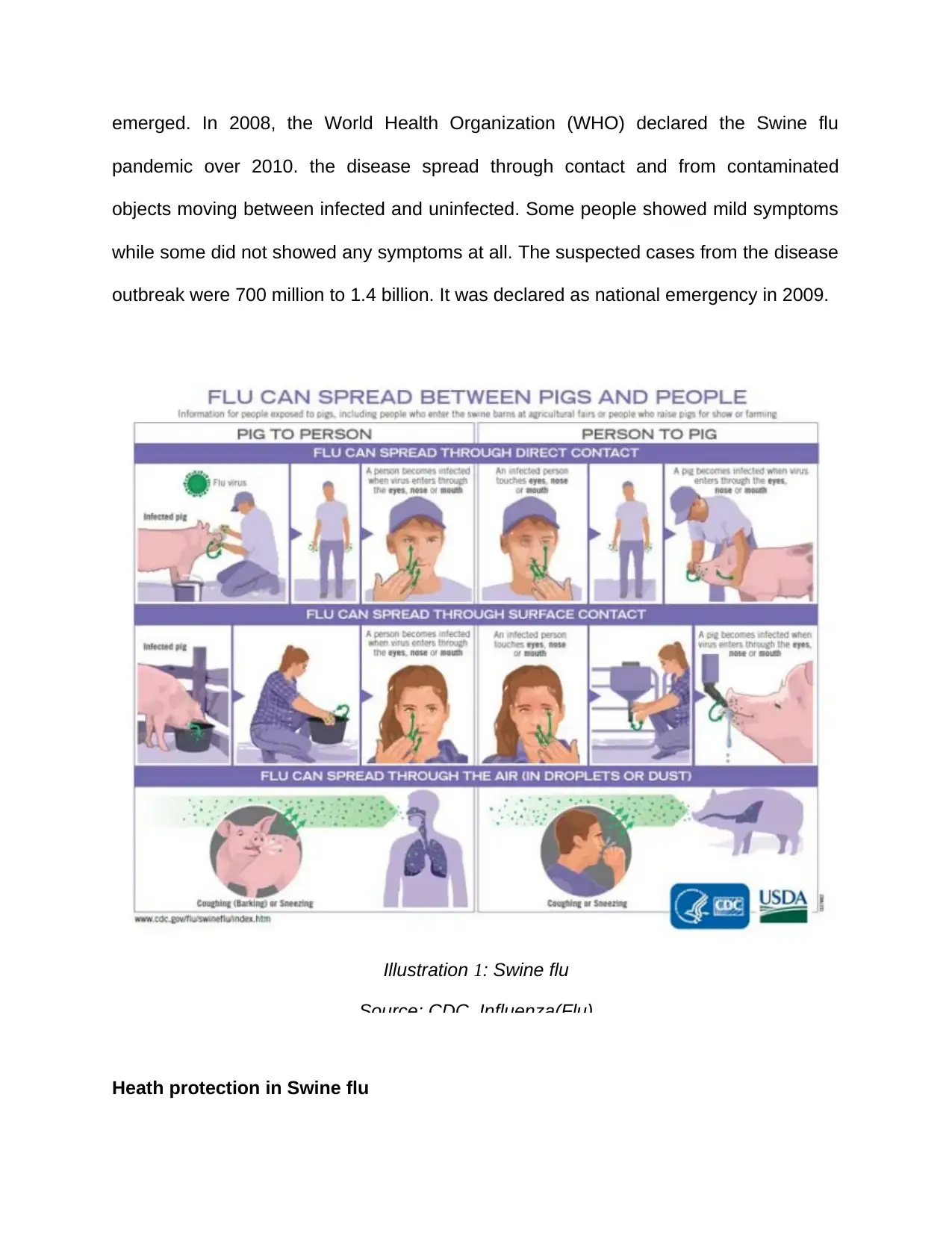
emerged. In 2008, the World Health Organization (WHO) declared the Swine flu
pandemic over 2010. the disease spread through contact and from contaminated
objects moving between infected and uninfected. Some people showed mild symptoms
while some did not showed any symptoms at all. The suspected cases from the disease
outbreak were 700 million to 1.4 billion. It was declared as national emergency in 2009.
Heath protection in Swine flu
Illustration 1: Swine flu
Source: CDC. Influenza(Flu)
pandemic over 2010. the disease spread through contact and from contaminated
objects moving between infected and uninfected. Some people showed mild symptoms
while some did not showed any symptoms at all. The suspected cases from the disease
outbreak were 700 million to 1.4 billion. It was declared as national emergency in 2009.
Heath protection in Swine flu
Illustration 1: Swine flu
Source: CDC. Influenza(Flu)
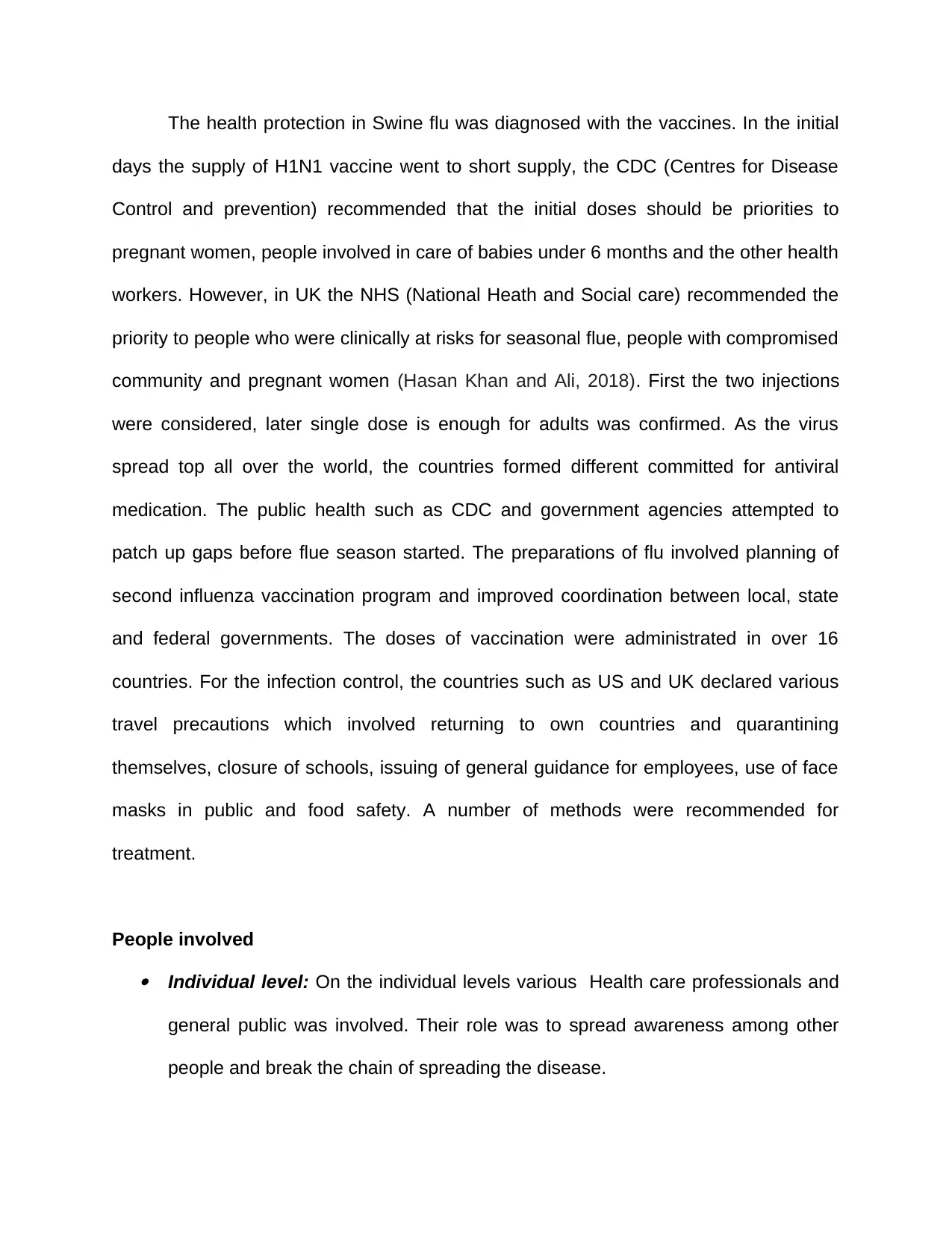
The health protection in Swine flu was diagnosed with the vaccines. In the initial
days the supply of H1N1 vaccine went to short supply, the CDC (Centres for Disease
Control and prevention) recommended that the initial doses should be priorities to
pregnant women, people involved in care of babies under 6 months and the other health
workers. However, in UK the NHS (National Heath and Social care) recommended the
priority to people who were clinically at risks for seasonal flue, people with compromised
community and pregnant women (Hasan Khan and Ali, 2018). First the two injections
were considered, later single dose is enough for adults was confirmed. As the virus
spread top all over the world, the countries formed different committed for antiviral
medication. The public health such as CDC and government agencies attempted to
patch up gaps before flue season started. The preparations of flu involved planning of
second influenza vaccination program and improved coordination between local, state
and federal governments. The doses of vaccination were administrated in over 16
countries. For the infection control, the countries such as US and UK declared various
travel precautions which involved returning to own countries and quarantining
themselves, closure of schools, issuing of general guidance for employees, use of face
masks in public and food safety. A number of methods were recommended for
treatment.
People involved Individual level: On the individual levels various Health care professionals and
general public was involved. Their role was to spread awareness among other
people and break the chain of spreading the disease.
days the supply of H1N1 vaccine went to short supply, the CDC (Centres for Disease
Control and prevention) recommended that the initial doses should be priorities to
pregnant women, people involved in care of babies under 6 months and the other health
workers. However, in UK the NHS (National Heath and Social care) recommended the
priority to people who were clinically at risks for seasonal flue, people with compromised
community and pregnant women (Hasan Khan and Ali, 2018). First the two injections
were considered, later single dose is enough for adults was confirmed. As the virus
spread top all over the world, the countries formed different committed for antiviral
medication. The public health such as CDC and government agencies attempted to
patch up gaps before flue season started. The preparations of flu involved planning of
second influenza vaccination program and improved coordination between local, state
and federal governments. The doses of vaccination were administrated in over 16
countries. For the infection control, the countries such as US and UK declared various
travel precautions which involved returning to own countries and quarantining
themselves, closure of schools, issuing of general guidance for employees, use of face
masks in public and food safety. A number of methods were recommended for
treatment.
People involved Individual level: On the individual levels various Health care professionals and
general public was involved. Their role was to spread awareness among other
people and break the chain of spreading the disease.
Secure Best Marks with AI Grader
Need help grading? Try our AI Grader for instant feedback on your assignments.
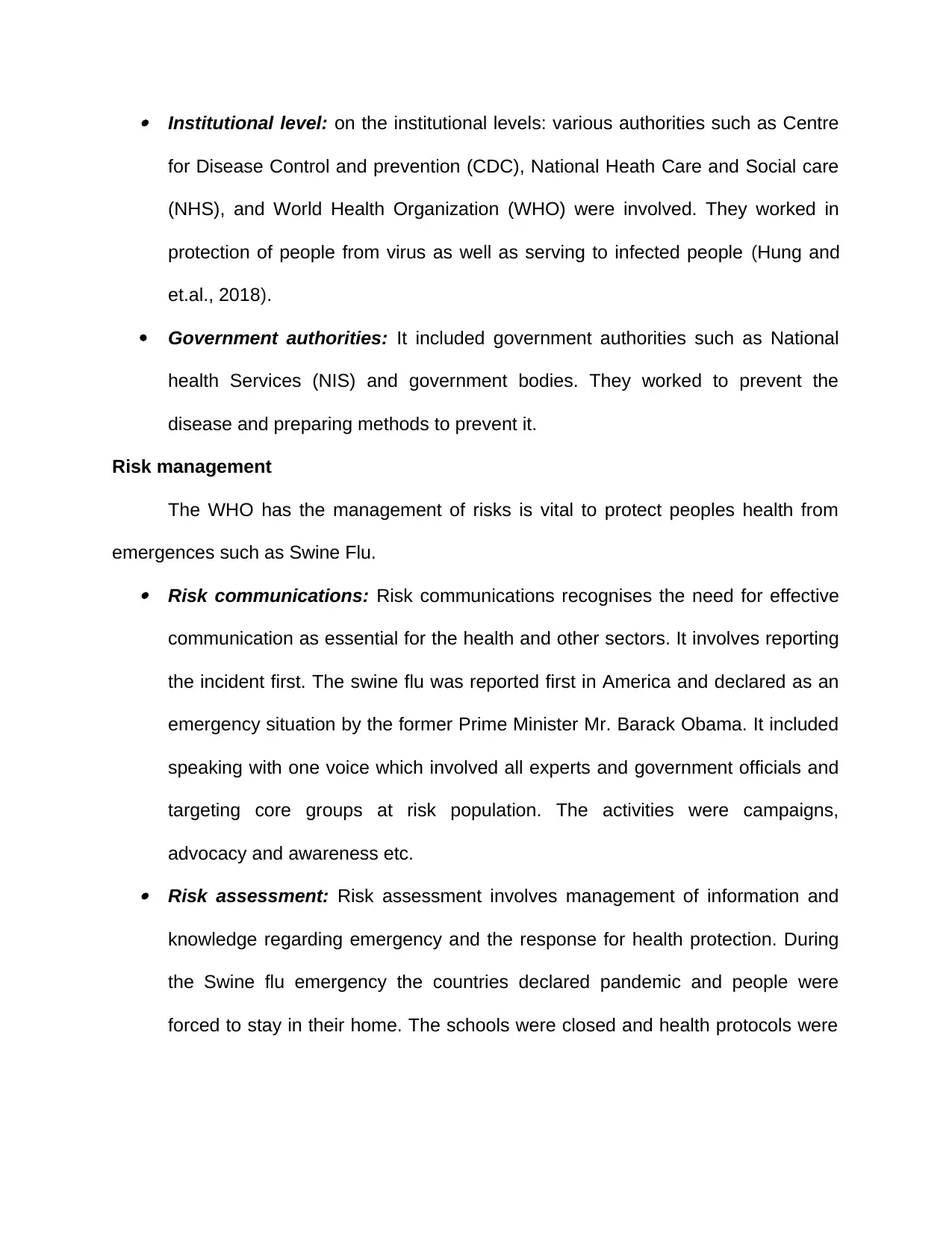
Institutional level: on the institutional levels: various authorities such as Centre
for Disease Control and prevention (CDC), National Heath Care and Social care
(NHS), and World Health Organization (WHO) were involved. They worked in
protection of people from virus as well as serving to infected people (Hung and
et.al., 2018).
Government authorities: It included government authorities such as National
health Services (NIS) and government bodies. They worked to prevent the
disease and preparing methods to prevent it.
Risk management
The WHO has the management of risks is vital to protect peoples health from
emergences such as Swine Flu. Risk communications: Risk communications recognises the need for effective
communication as essential for the health and other sectors. It involves reporting
the incident first. The swine flu was reported first in America and declared as an
emergency situation by the former Prime Minister Mr. Barack Obama. It included
speaking with one voice which involved all experts and government officials and
targeting core groups at risk population. The activities were campaigns,
advocacy and awareness etc. Risk assessment: Risk assessment involves management of information and
knowledge regarding emergency and the response for health protection. During
the Swine flu emergency the countries declared pandemic and people were
forced to stay in their home. The schools were closed and health protocols were
for Disease Control and prevention (CDC), National Heath Care and Social care
(NHS), and World Health Organization (WHO) were involved. They worked in
protection of people from virus as well as serving to infected people (Hung and
et.al., 2018).
Government authorities: It included government authorities such as National
health Services (NIS) and government bodies. They worked to prevent the
disease and preparing methods to prevent it.
Risk management
The WHO has the management of risks is vital to protect peoples health from
emergences such as Swine Flu. Risk communications: Risk communications recognises the need for effective
communication as essential for the health and other sectors. It involves reporting
the incident first. The swine flu was reported first in America and declared as an
emergency situation by the former Prime Minister Mr. Barack Obama. It included
speaking with one voice which involved all experts and government officials and
targeting core groups at risk population. The activities were campaigns,
advocacy and awareness etc. Risk assessment: Risk assessment involves management of information and
knowledge regarding emergency and the response for health protection. During
the Swine flu emergency the countries declared pandemic and people were
forced to stay in their home. The schools were closed and health protocols were
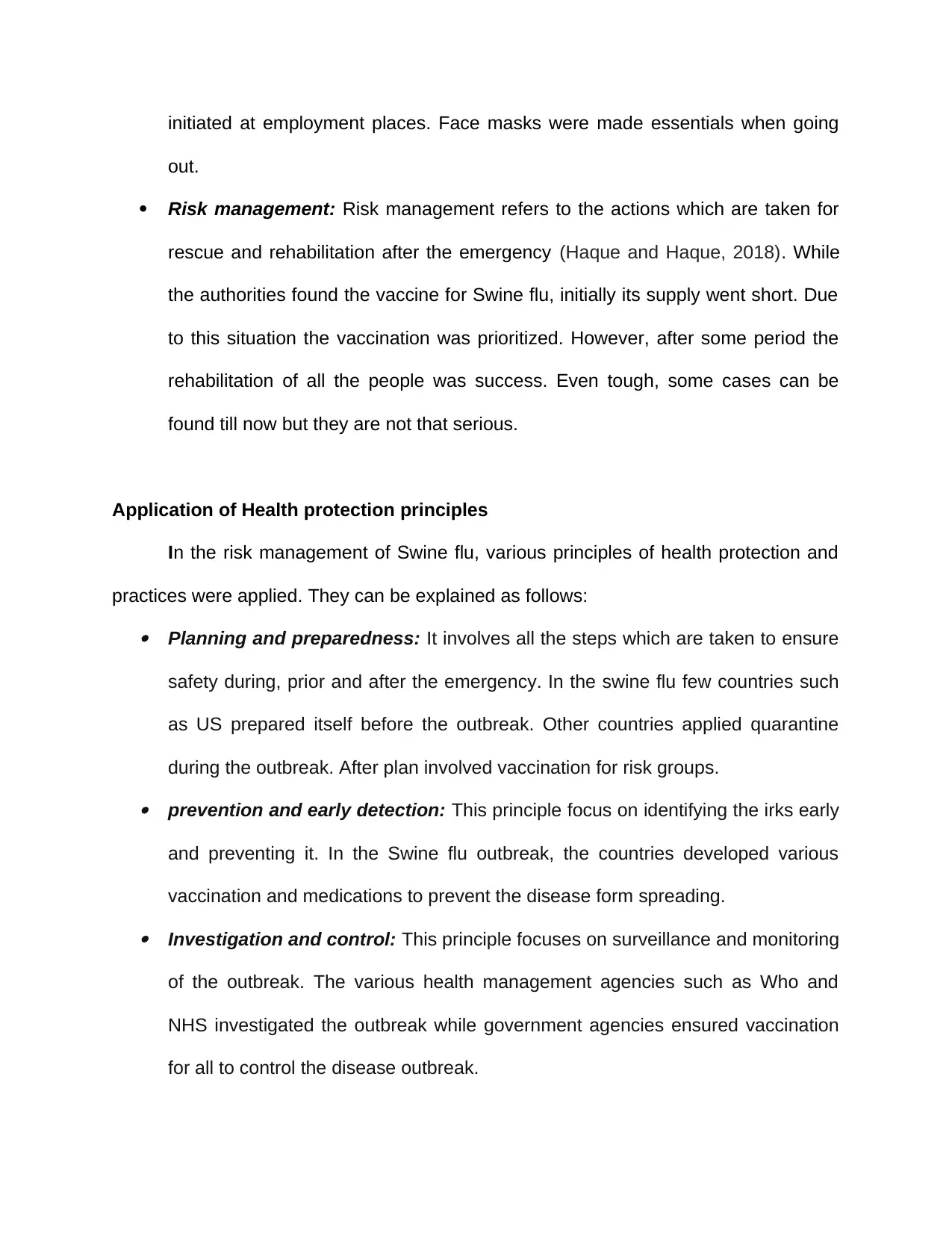
initiated at employment places. Face masks were made essentials when going
out.
Risk management: Risk management refers to the actions which are taken for
rescue and rehabilitation after the emergency (Haque and Haque, 2018). While
the authorities found the vaccine for Swine flu, initially its supply went short. Due
to this situation the vaccination was prioritized. However, after some period the
rehabilitation of all the people was success. Even tough, some cases can be
found till now but they are not that serious.
Application of Health protection principles
In the risk management of Swine flu, various principles of health protection and
practices were applied. They can be explained as follows: Planning and preparedness: It involves all the steps which are taken to ensure
safety during, prior and after the emergency. In the swine flu few countries such
as US prepared itself before the outbreak. Other countries applied quarantine
during the outbreak. After plan involved vaccination for risk groups. prevention and early detection: This principle focus on identifying the irks early
and preventing it. In the Swine flu outbreak, the countries developed various
vaccination and medications to prevent the disease form spreading. Investigation and control: This principle focuses on surveillance and monitoring
of the outbreak. The various health management agencies such as Who and
NHS investigated the outbreak while government agencies ensured vaccination
for all to control the disease outbreak.
out.
Risk management: Risk management refers to the actions which are taken for
rescue and rehabilitation after the emergency (Haque and Haque, 2018). While
the authorities found the vaccine for Swine flu, initially its supply went short. Due
to this situation the vaccination was prioritized. However, after some period the
rehabilitation of all the people was success. Even tough, some cases can be
found till now but they are not that serious.
Application of Health protection principles
In the risk management of Swine flu, various principles of health protection and
practices were applied. They can be explained as follows: Planning and preparedness: It involves all the steps which are taken to ensure
safety during, prior and after the emergency. In the swine flu few countries such
as US prepared itself before the outbreak. Other countries applied quarantine
during the outbreak. After plan involved vaccination for risk groups. prevention and early detection: This principle focus on identifying the irks early
and preventing it. In the Swine flu outbreak, the countries developed various
vaccination and medications to prevent the disease form spreading. Investigation and control: This principle focuses on surveillance and monitoring
of the outbreak. The various health management agencies such as Who and
NHS investigated the outbreak while government agencies ensured vaccination
for all to control the disease outbreak.
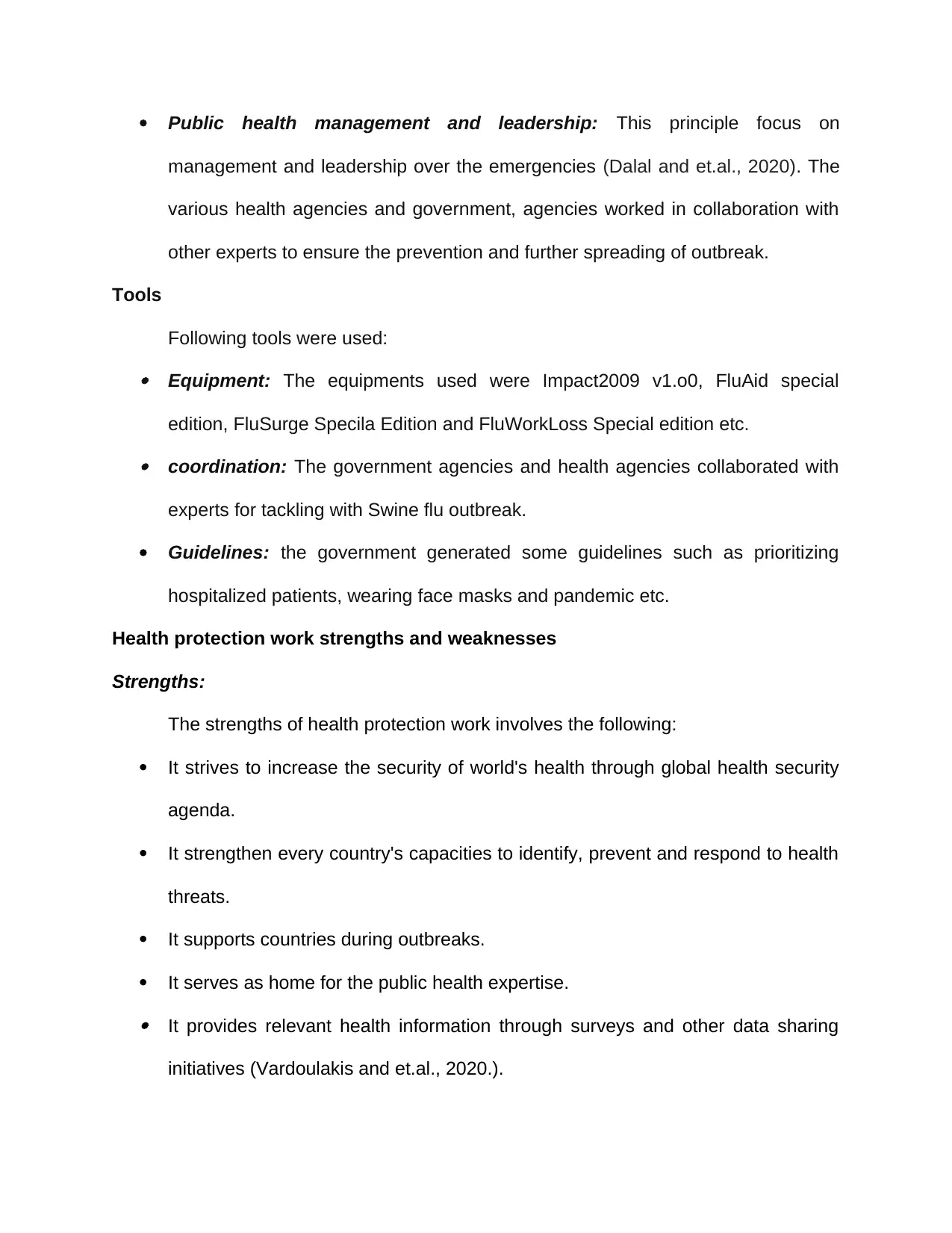
Public health management and leadership: This principle focus on
management and leadership over the emergencies (Dalal and et.al., 2020). The
various health agencies and government, agencies worked in collaboration with
other experts to ensure the prevention and further spreading of outbreak.
Tools
Following tools were used: Equipment: The equipments used were Impact2009 v1.o0, FluAid special
edition, FluSurge Specila Edition and FluWorkLoss Special edition etc. coordination: The government agencies and health agencies collaborated with
experts for tackling with Swine flu outbreak.
Guidelines: the government generated some guidelines such as prioritizing
hospitalized patients, wearing face masks and pandemic etc.
Health protection work strengths and weaknesses
Strengths:
The strengths of health protection work involves the following:
It strives to increase the security of world's health through global health security
agenda.
It strengthen every country's capacities to identify, prevent and respond to health
threats.
It supports countries during outbreaks.
It serves as home for the public health expertise. It provides relevant health information through surveys and other data sharing
initiatives (Vardoulakis and et.al., 2020.).
management and leadership over the emergencies (Dalal and et.al., 2020). The
various health agencies and government, agencies worked in collaboration with
other experts to ensure the prevention and further spreading of outbreak.
Tools
Following tools were used: Equipment: The equipments used were Impact2009 v1.o0, FluAid special
edition, FluSurge Specila Edition and FluWorkLoss Special edition etc. coordination: The government agencies and health agencies collaborated with
experts for tackling with Swine flu outbreak.
Guidelines: the government generated some guidelines such as prioritizing
hospitalized patients, wearing face masks and pandemic etc.
Health protection work strengths and weaknesses
Strengths:
The strengths of health protection work involves the following:
It strives to increase the security of world's health through global health security
agenda.
It strengthen every country's capacities to identify, prevent and respond to health
threats.
It supports countries during outbreaks.
It serves as home for the public health expertise. It provides relevant health information through surveys and other data sharing
initiatives (Vardoulakis and et.al., 2020.).
Paraphrase This Document
Need a fresh take? Get an instant paraphrase of this document with our AI Paraphraser
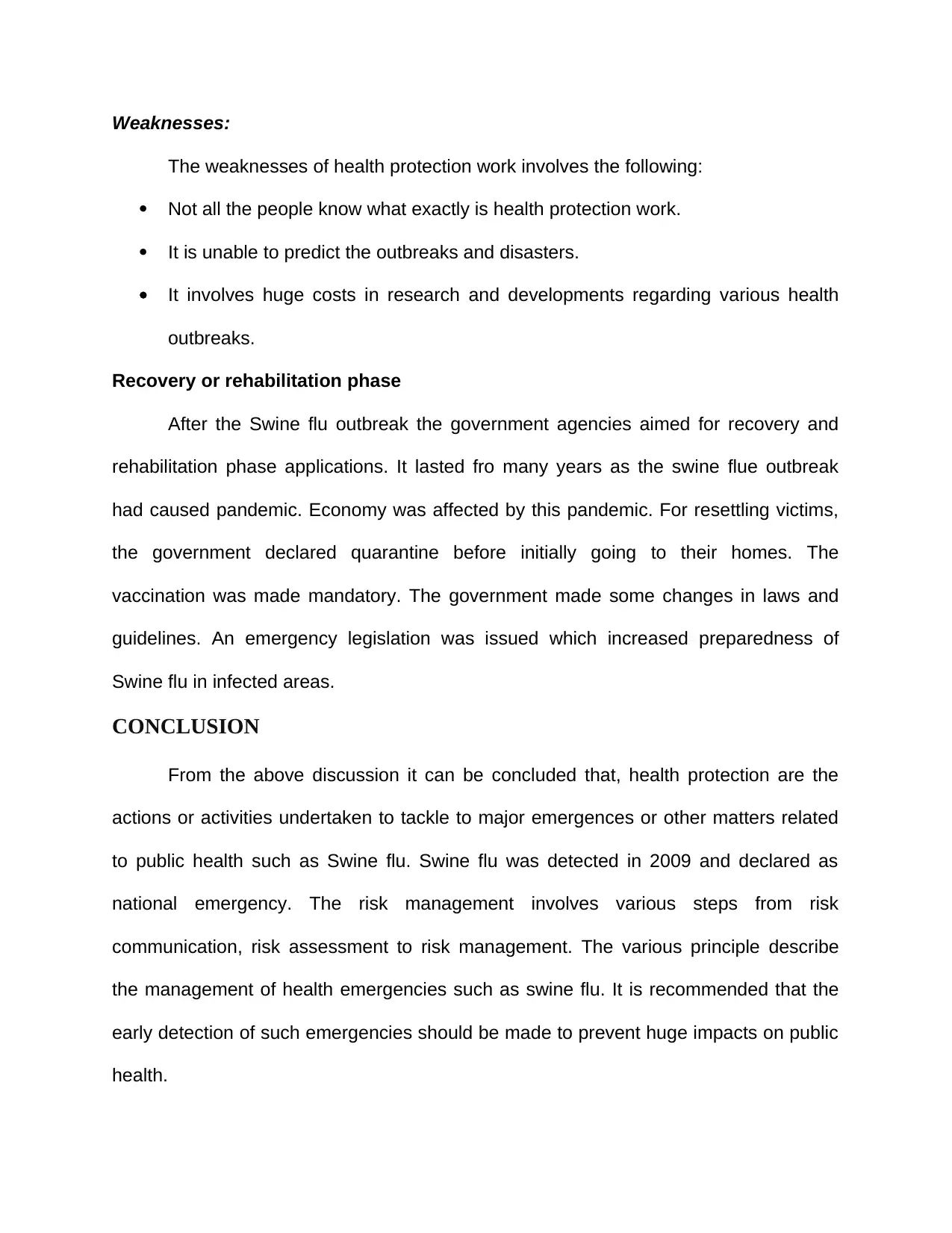
Weaknesses:
The weaknesses of health protection work involves the following:
Not all the people know what exactly is health protection work.
It is unable to predict the outbreaks and disasters.
It involves huge costs in research and developments regarding various health
outbreaks.
Recovery or rehabilitation phase
After the Swine flu outbreak the government agencies aimed for recovery and
rehabilitation phase applications. It lasted fro many years as the swine flue outbreak
had caused pandemic. Economy was affected by this pandemic. For resettling victims,
the government declared quarantine before initially going to their homes. The
vaccination was made mandatory. The government made some changes in laws and
guidelines. An emergency legislation was issued which increased preparedness of
Swine flu in infected areas.
CONCLUSION
From the above discussion it can be concluded that, health protection are the
actions or activities undertaken to tackle to major emergences or other matters related
to public health such as Swine flu. Swine flu was detected in 2009 and declared as
national emergency. The risk management involves various steps from risk
communication, risk assessment to risk management. The various principle describe
the management of health emergencies such as swine flu. It is recommended that the
early detection of such emergencies should be made to prevent huge impacts on public
health.
The weaknesses of health protection work involves the following:
Not all the people know what exactly is health protection work.
It is unable to predict the outbreaks and disasters.
It involves huge costs in research and developments regarding various health
outbreaks.
Recovery or rehabilitation phase
After the Swine flu outbreak the government agencies aimed for recovery and
rehabilitation phase applications. It lasted fro many years as the swine flue outbreak
had caused pandemic. Economy was affected by this pandemic. For resettling victims,
the government declared quarantine before initially going to their homes. The
vaccination was made mandatory. The government made some changes in laws and
guidelines. An emergency legislation was issued which increased preparedness of
Swine flu in infected areas.
CONCLUSION
From the above discussion it can be concluded that, health protection are the
actions or activities undertaken to tackle to major emergences or other matters related
to public health such as Swine flu. Swine flu was detected in 2009 and declared as
national emergency. The risk management involves various steps from risk
communication, risk assessment to risk management. The various principle describe
the management of health emergencies such as swine flu. It is recommended that the
early detection of such emergencies should be made to prevent huge impacts on public
health.
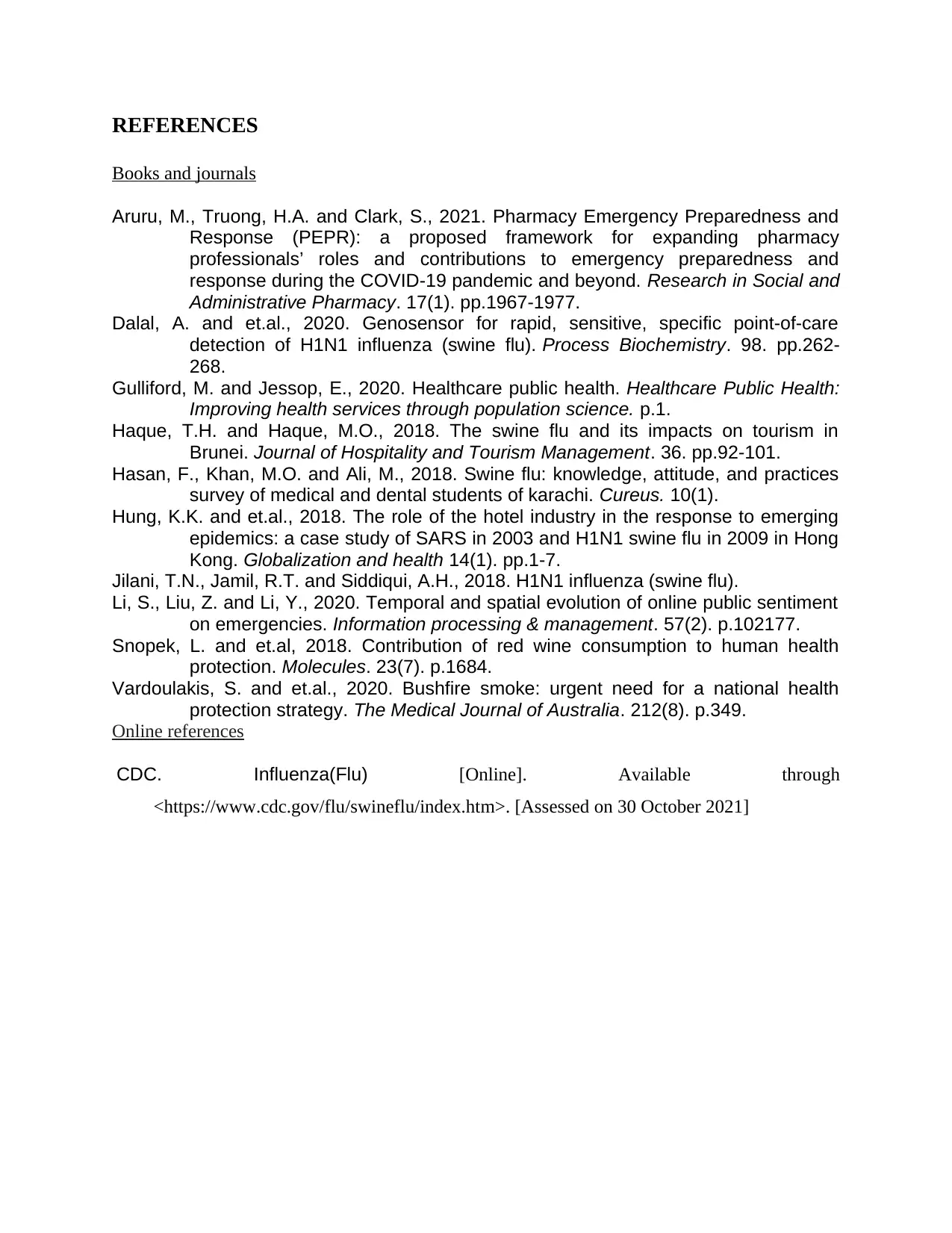
REFERENCES
Books and journals
Aruru, M., Truong, H.A. and Clark, S., 2021. Pharmacy Emergency Preparedness and
Response (PEPR): a proposed framework for expanding pharmacy
professionals’ roles and contributions to emergency preparedness and
response during the COVID-19 pandemic and beyond. Research in Social and
Administrative Pharmacy. 17(1). pp.1967-1977.
Dalal, A. and et.al., 2020. Genosensor for rapid, sensitive, specific point-of-care
detection of H1N1 influenza (swine flu). Process Biochemistry. 98. pp.262-
268.
Gulliford, M. and Jessop, E., 2020. Healthcare public health. Healthcare Public Health:
Improving health services through population science. p.1.
Haque, T.H. and Haque, M.O., 2018. The swine flu and its impacts on tourism in
Brunei. Journal of Hospitality and Tourism Management. 36. pp.92-101.
Hasan, F., Khan, M.O. and Ali, M., 2018. Swine flu: knowledge, attitude, and practices
survey of medical and dental students of karachi. Cureus. 10(1).
Hung, K.K. and et.al., 2018. The role of the hotel industry in the response to emerging
epidemics: a case study of SARS in 2003 and H1N1 swine flu in 2009 in Hong
Kong. Globalization and health 14(1). pp.1-7.
Jilani, T.N., Jamil, R.T. and Siddiqui, A.H., 2018. H1N1 influenza (swine flu).
Li, S., Liu, Z. and Li, Y., 2020. Temporal and spatial evolution of online public sentiment
on emergencies. Information processing & management. 57(2). p.102177.
Snopek, L. and et.al, 2018. Contribution of red wine consumption to human health
protection. Molecules. 23(7). p.1684.
Vardoulakis, S. and et.al., 2020. Bushfire smoke: urgent need for a national health
protection strategy. The Medical Journal of Australia. 212(8). p.349.
Online references
CDC. Influenza(Flu) [Online]. Available through
<https://www.cdc.gov/flu/swineflu/index.htm>. [Assessed on 30 October 2021]
Books and journals
Aruru, M., Truong, H.A. and Clark, S., 2021. Pharmacy Emergency Preparedness and
Response (PEPR): a proposed framework for expanding pharmacy
professionals’ roles and contributions to emergency preparedness and
response during the COVID-19 pandemic and beyond. Research in Social and
Administrative Pharmacy. 17(1). pp.1967-1977.
Dalal, A. and et.al., 2020. Genosensor for rapid, sensitive, specific point-of-care
detection of H1N1 influenza (swine flu). Process Biochemistry. 98. pp.262-
268.
Gulliford, M. and Jessop, E., 2020. Healthcare public health. Healthcare Public Health:
Improving health services through population science. p.1.
Haque, T.H. and Haque, M.O., 2018. The swine flu and its impacts on tourism in
Brunei. Journal of Hospitality and Tourism Management. 36. pp.92-101.
Hasan, F., Khan, M.O. and Ali, M., 2018. Swine flu: knowledge, attitude, and practices
survey of medical and dental students of karachi. Cureus. 10(1).
Hung, K.K. and et.al., 2018. The role of the hotel industry in the response to emerging
epidemics: a case study of SARS in 2003 and H1N1 swine flu in 2009 in Hong
Kong. Globalization and health 14(1). pp.1-7.
Jilani, T.N., Jamil, R.T. and Siddiqui, A.H., 2018. H1N1 influenza (swine flu).
Li, S., Liu, Z. and Li, Y., 2020. Temporal and spatial evolution of online public sentiment
on emergencies. Information processing & management. 57(2). p.102177.
Snopek, L. and et.al, 2018. Contribution of red wine consumption to human health
protection. Molecules. 23(7). p.1684.
Vardoulakis, S. and et.al., 2020. Bushfire smoke: urgent need for a national health
protection strategy. The Medical Journal of Australia. 212(8). p.349.
Online references
CDC. Influenza(Flu) [Online]. Available through
<https://www.cdc.gov/flu/swineflu/index.htm>. [Assessed on 30 October 2021]

1 out of 16
Your All-in-One AI-Powered Toolkit for Academic Success.
+13062052269
info@desklib.com
Available 24*7 on WhatsApp / Email
![[object Object]](/_next/static/media/star-bottom.7253800d.svg)
Unlock your academic potential
© 2024 | Zucol Services PVT LTD | All rights reserved.
